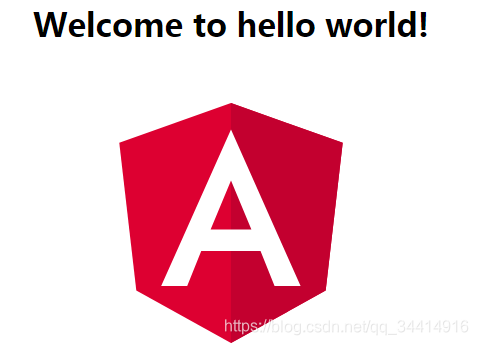如果有任何的非技术障碍,比如如何新建Angular项目,请先到我的"Angular7入门辅助教程"专栏参考这篇博客:Angular7入门辅助教程——前篇
这篇博客是Angular7入门辅助教程的结束篇,学了这么多,我想你应该有写.......hello world的水平了吧,什么,要写helloworld,别说话,我只写hello world,其他的别来找我——接下来,我将带你利用Angular输出形形色色的......hello world!
1、利用模板表达式输出hello world
这个最简单,新建Angular项目,将AppComponent类中的title属性改成下面这句代码
title = 'hello world';现在,启动应用,现在,你的界面应该如下

2、利用管道输出hello world
现在,我们来写一个神奇的管道——helloworld,他能将任何输入都转化为hello world,并输出打破屏幕上
1)、新建一个名叫test-teaching-a的项目,并cd进该项目目录
2)、新建一个名叫helloworld的管道
ng generate pipe helloworld3)、修改helloworld.pipe.ts文件内容如下
import { Pipe, PipeTransform } from '@angular/core';
@Pipe({
name: 'helloworld'
})
export class HelloworldPipe implements PipeTransform {
transform(value: any, args?: any): any {
return 'hello world';
}
}也就是return 'hello world',其他的地方不用改
4)、在AppComponent类中添加下面这句代码
title1 = 'I am not hello world';5)、修改app.component.html文件如下
<h1>{{ title1 | helloworld }}</h1>6)、然后启动应用,可以看到,界面上的hello world
3、利用服务输出hello world
1)、在上个例子的基础上,新建一个名叫helloworld的服务
ng generate service helloworld并添加下一面这个方法
getHellloworld() {
return 'hello world';
}2)、修改app.component.ts文件如下
import { Component } from '@angular/core';
import { HelloworldService } from './helloworld.service';
@Component({
selector: 'app-root',
templateUrl: './app.component.html',
styleUrls: ['./app.component.css']
})
export class AppComponent {
title = 'hello world';
title1 = 'I am not hello world';
title2 = this.title1;
constructor(private helloworldService: HelloworldService) {
this.title2 = this.helloworldService.getHellloworld();
}
}3)、修改app.component.html文件如下
利用模板表达式输出hello world:
<h1>{{ title }}</h1>
<hr />
利用管道输出hello world:
<h1>{{ title1 | helloworld }}</h1>
<hr />
利用服务输出hello world:
<h1>{{ title2 }}</h1>4)、你的界面出现了第三个hello world
4、利用HttpClient服务输出hello world
1)、在src/assets目录下面新建一个helloworld.txt文件,内容如下
hello world2)、在helloworld.service.ts文件中添加下面这些代码
constructor(private httpClient: HttpClient) {}getHelloworld2() {
return this.httpClient.get('../assets/helloworld.txt', {
responseType: 'text'
});
}3)、app.component.ts文件中添加下面这些代码片段
title3 = this.title1;在构造函数中添加下面的代码段
this.helloworldService.getHelloworld2().subscribe(data => {
this.title3 = data;
});4)、在app.component.html文件结尾添加下面代码
<hr>
利用HttpClient服务输出hello world
<h1>{{ title3 }}</h1>
<hr>5)、在AppModule中引入HttpClientModule,以便使用HttpClient服务
import { HttpClientModule } from '@angular/common/http';imports: [
BrowserModule,
HttpClientModule
],6)、现在你的界面出现了第4个hello world
5、利用Observable输出hello world
1)、在helloworld.service.ts中加入下面代码
import { of } from 'rxjs';getHelloworld5() {
let helloworld = '';
const helloworldOb = of('hello world');
helloworldOb.subscribe(data => {
helloworld = data;
});
return helloworld;
}2)、在app.component.ts文件中添加下面这些代码片段
title5 = this.title1;在构造函数中添加下面代码
this.title5 = this.helloworldService.getHelloworld5();3)、在app.component.html文件结尾添加下面代码
利用Observable输出hello world:
<h1>{{ title5 }}</h1>
<hr>现在,你的应用应该出现了第5个hello world
6、利用RxJS库中的操作符输出hello world
1)、在helloworld.service.ts中加入下面代码
getHelloworld6() {
const helloworldOb = of(
'I am not hello world',
'I am not hello world',
'I am not hello world'
);
return helloworldOb;
}2)、在app.component.ts文件中添加下面这些代码片段
titles6: string[] = [];在构造函数中添加下面代码
this.helloworldService
.getHelloworld6()
.pipe(map(_ => 'hello world'))
.subscribe(helloworld => {
this.titles6.push(helloworld);
});3)、在app.component.html文件结尾添加下面代码
利用RxJS库中的map操作符输出hello world:
<ul>
<li *ngFor="let helloworld of titles6">{{helloworld}}</li>
</ul>
<hr>这时,你的界面多了三个小的hello world
7、利用useValue服务提供商输出hello world
1)、在src/app目录下新建一个名叫assist.ts的文件,内容如下
import { InjectionToken } from '@angular/core';
export const HELLO_WORLD_TOKEN = new InjectionToken<string>('hello world');
export const useValueProvider = {
provide: HELLO_WORLD_TOKEN,
useValue: 'hello world'
};2)、在app.component.ts文件中添加下面这些代码片段
providers: [useValueProvider] title7 = this.title1;在构造函数中添加下面代码
constructor(
private helloworldService: HelloworldService,
@Inject(HELLO_WORLD_TOKEN) private helloworldStr: string
) this.title7 = this.helloworldStr;3)、在app.component.html文件结尾添加下面代码
利用useValue服务提供商输出hello world:
<h1>{{ title7 }}</h1>
<hr>现在,你的界面应该出现了第7个hello world
8、利用useFactory服务提供商输出hello world
1)、新建一个名叫helloworldFactory的服务,内容如下
import { Injectable } from '@angular/core';
@Injectable({
providedIn: 'root'
})
export class HelloworldFactoryService {
constructor(public helloworld: string) {}
getHelloworld() {
return this.helloworld;
}
}2)、在assist.ts文件中添加下面代码段
function helloworldFactory() {
return new HelloworldFactoryService('hello world');
}
export const useFactoryProvider = {
provide: HelloworldFactoryService,
useFactory: helloworldFactory,
deps: []
};3)、在app.component.ts文件中添加下面这些代码片段
providers: [useValueProvider, useFactoryProvider] title8 = this.title1;在构造函数中添加下面代码
constructor(
private helloworldService: HelloworldService,
@Inject(HELLO_WORLD_TOKEN) private helloworldStr: string,
private helloworldFactoryService: HelloworldFactoryService
) this.title8 = this.helloworldFactoryService.getHelloworld();4)、 在app.component.html文件结尾添加下面代码
利用useFactory服务提供商输出hello world:
<h1>{{ title8 }}</h1>
<hr>现在。你的界面应该出现了第8个hello world
9、利用双向绑定输出hello world
1)、在app.component.ts文件中添加下面这些代码片段
title9 = '';2)、 在app.component.html文件结尾添加下面代码
利用双向绑定输出hello world:
<input [(ngModel)]="title9">
<h1>{{ title9 }}</h1>
<hr>3)、在AppModule中引入FormsModule(因为ngModel指令属于FormsModule模块)
imports: [
BrowserModule,
HttpClientModule,
FormsModule
],在界面输入框中输入hello world,这是这个输入框的下方出现了第9个hello world
这些hello world你都能输出吗?最后,你的界面应该是下面这样子的

其实,将app.component.ts中AppComponent的构造函数中的内容移至OnInit函数中才是最佳实践,这一步读者可以自行完成
源码下载地址:helloworld小项目
好了,这个教程到处结束了,你是否还记得我在(Angular7入门辅助教程——前篇)中讲到的学完本教程能达到的水平

那么,现在就可以去看一下官网的这个快速入门教程,看看是否还有疑问!










 这篇博客作为Angular7入门教程的总结篇,详细介绍了如何利用Angular输出各种形式的'Hello World',涵盖了模板表达式、管道、服务、HttpClient、Observable、RxJS操作符、服务提供商等多种方式。通过实例教学,帮助读者巩固和提升Angular技能。
这篇博客作为Angular7入门教程的总结篇,详细介绍了如何利用Angular输出各种形式的'Hello World',涵盖了模板表达式、管道、服务、HttpClient、Observable、RxJS操作符、服务提供商等多种方式。通过实例教学,帮助读者巩固和提升Angular技能。
















 7904
7904

 被折叠的 条评论
为什么被折叠?
被折叠的 条评论
为什么被折叠?








